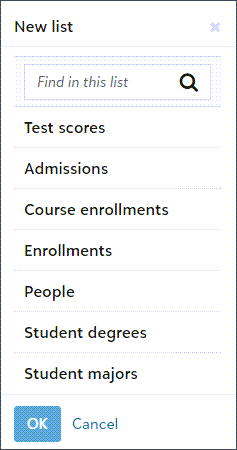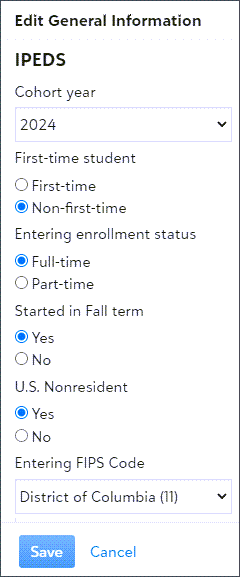IPEDS Lists Guide
Higher Ed schools should use Lists in Analysis in the Education Area to find, export, and organize data for the Integrated Postsecondary Education Data System (IPEDS) in Blackbaud Education Management.
For details about IPEDS and to download the current survey forms, visit the IPEDS page on the National Center for Education Statistics website.
The lists you'll use for IPEDS reports are similar to other SKY lists throughout Blackbaud Education Management.
Configure Access to IPEDS Lists
A platform manager who is is an Environment admin or or is a Organization (site) administrator should create roles.
-
Select Analysis from the top navigation menu.

Alternatively, from your Home dashboard in Core, select Go to Education area under Tasks.
-
Next, select Control panel, select Security, and then select Roles.
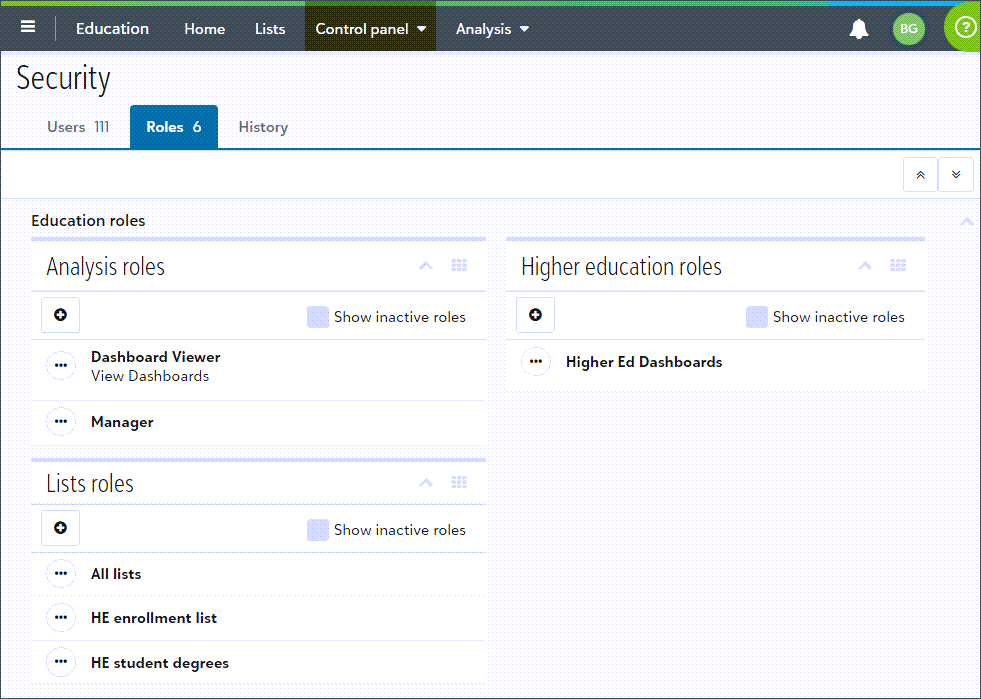
-
Under Higher Education roles, select + Create role. Next, enter a Role name and Description. You can also copy an existing role to create a new role. Then select Show permissions and choose which dashboards users with this role should be able to access. Select Save.
-
Under List roles, select + Create role. Next, enter a Role name and Description. You can also copy an existing role to create a new role. Then select Show permissions and choose which lists and data users with this role should be able to access. Select Save.
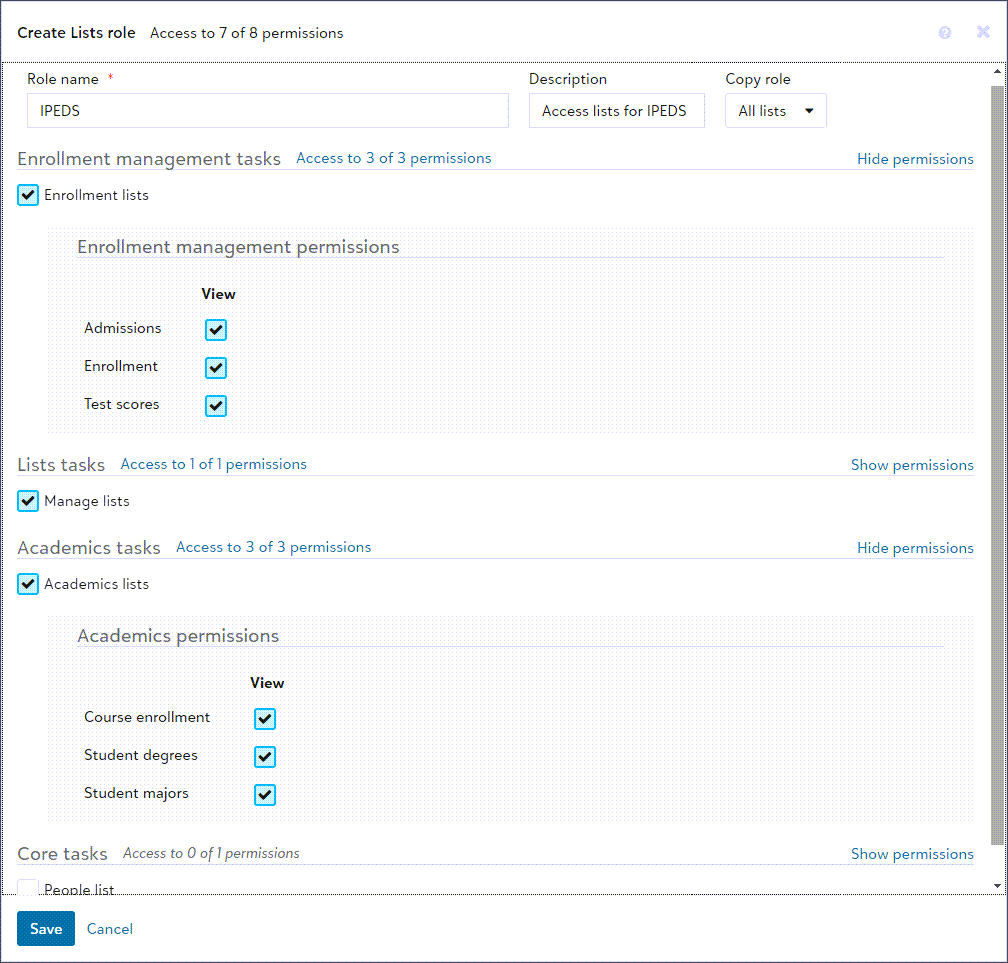
-
Then add users as members of the roles.
-
From Control panel, select Security and then select Users.
-
Find a existing user. On their row, select (...) and then select Manage Roles.
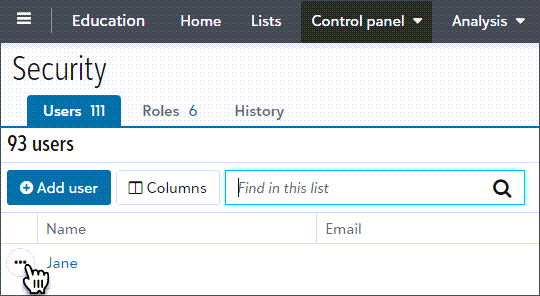
Alternatively, select + Add user. Next enter First name, Last name, and Email address. Then select to Link to an existing user from Core or elseCreate a new user.
-
Select which Lists, Higher education dashboards, or other features the user should have a security role to access.
-
Select Save or Send invite.
-
Note: Not quite ready to use the new lists? Refer to previous IPEDS guide for instructions about how to use alternative lists and reports.
Navigate to Lists
To go the Education Area, as a platform manager who
-
is an Environment admin
-
or is a Organization (site) administrator
select Go to Education area from your Home dashboard in Core. Then select Lists.
Alternatively, as a user who has been granted access to lists, select Analysis from the top navigation menu and then select Lists.
Tip: If you’re familiar with Raiser’s Edge NXT, this is like going to “web view.” The top navigation menu for the Education area will be a gray color (and is sometimes call an "omnibar").
List features
Similar to other SKY lists, you can:
-
Search for a record in the list
-
Select which columns of details to view
-
Reorder columns (drag and drop the column headers)
-
Sort by a column (select the column header, select twice to reverse the sort)
-
Filter based on criteria
-
Create a new list by duplicating an existing list and restrict who can change the new list
-
Save the filters to view the list later
-
Rename or delete lists you've saved
-
Export data to a spreadsheet application (such as Microsoft Excel) and use that application to print
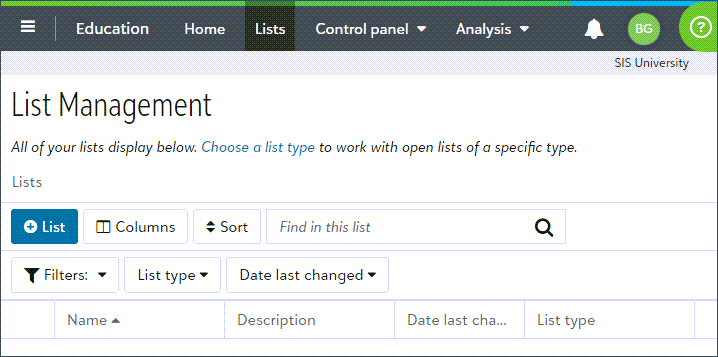
List types
Some lists types correspond to multiple IPEDS components. Thus, you'll use those lists types multiple times to report data:
|
Admissions
Course enrollments
Enrollments
Student degrees/certificates
Test scores
|
|
Three additional lists do not directly correspond to IPEDS. These lists enable you to report additional information about
-
People
-
Student majors
-
Users
to your school's stakeholders.
User Profiles
Students' user profiles are the source of some IPEDS specific data fields for these lists.
To update the data for a student in the list, go to their user profile in Core and select Contact card. Then select Edit under General information.
Then Edit the user's Citizenship/Resident information.
|
|
Enter the user's:
|
Tip: Consider entering Pell grant status as an admin-only field on each student's profile. For more information on creating admin-only fields, see the help topic Custom user fields . You can also set up sub-cohorts as custom user fields, if desired.
To edit cohort data in bulk:
-
From Core, select System tools, then Data import.
-
Select Create import job.
-
For Category, select Contact Card-Import/Refresh.
-
For Import type, select IPEDS.
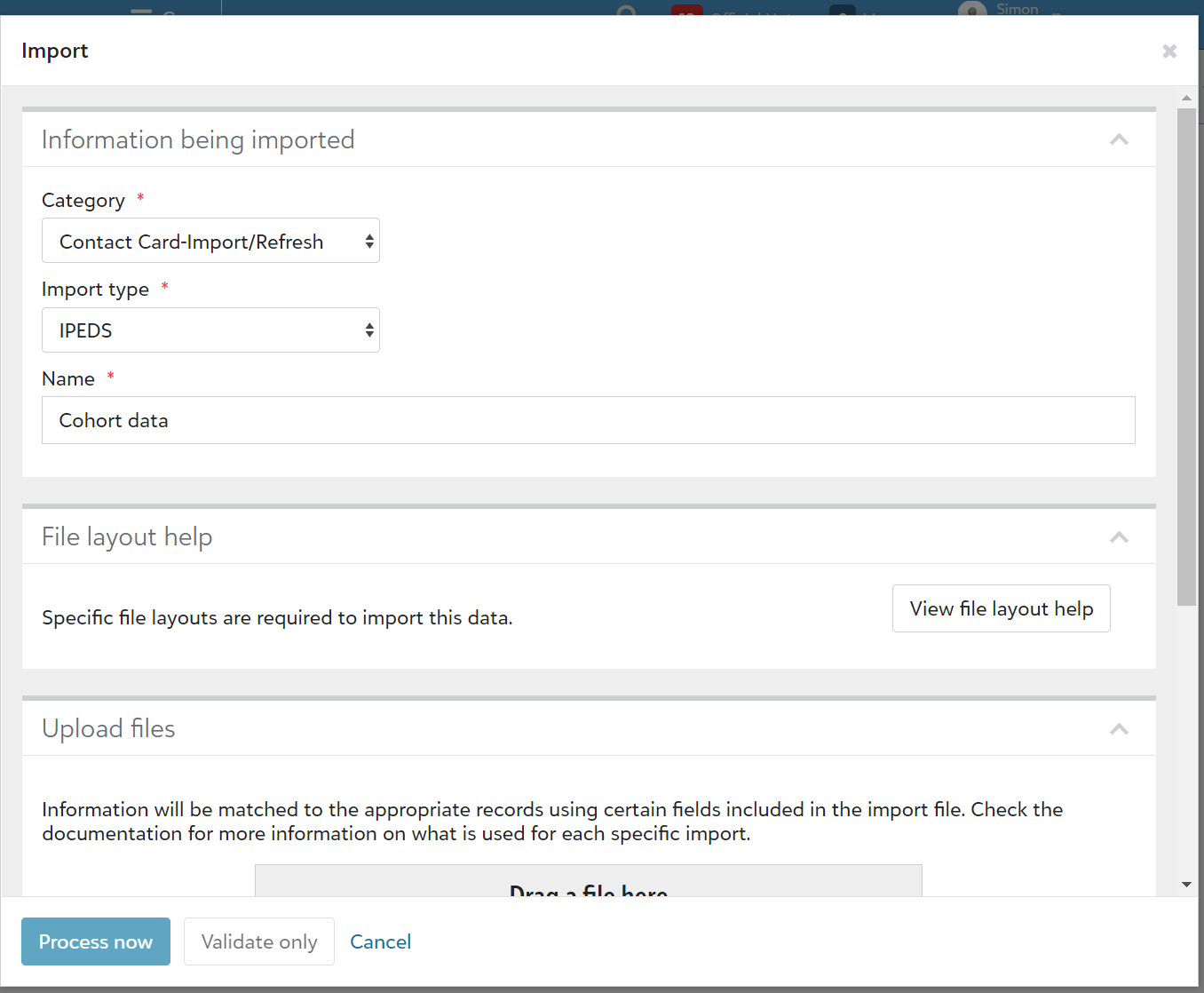
-
Enter a Name for the import.
-
Select View file layout help for more instructions. Here you can download a sample file with the required fields and then edit it using spreadsheet software.
-
Select Cancel to return to the Data import screen. Upload your completed spreadsheet or drag into the Drag a file here box.
-
Select Process now.
IPEDS Integration Mapping
Since some fields of data in Blackbaud Education Management may not exactly match those required by IPEDS, you should also configure how you want the data from Core and Academics to map to corresponding fields for IPEDS.
For example, your school might use more options for Gender, Race, and Withdrawal reason than IPEDS requires. To complete IPEDS reporting, you'll match your school's unique values to the closest appropriate IPEDS option.
-
As a platform manager, go to Core, select Settings, and then select Integration Mappings.
-
Select IPEDS to view the IPEDS fields you'll need to map.
-
For each IPEDS field, you'll the values available at your school. Find which of your school's values that are Not Mapped and on it's row, select Edit.
-
For Mapping, select a corresponding IPEDS field. Data from your school's value will appear as this mapped value in IPEDS lists and reports.
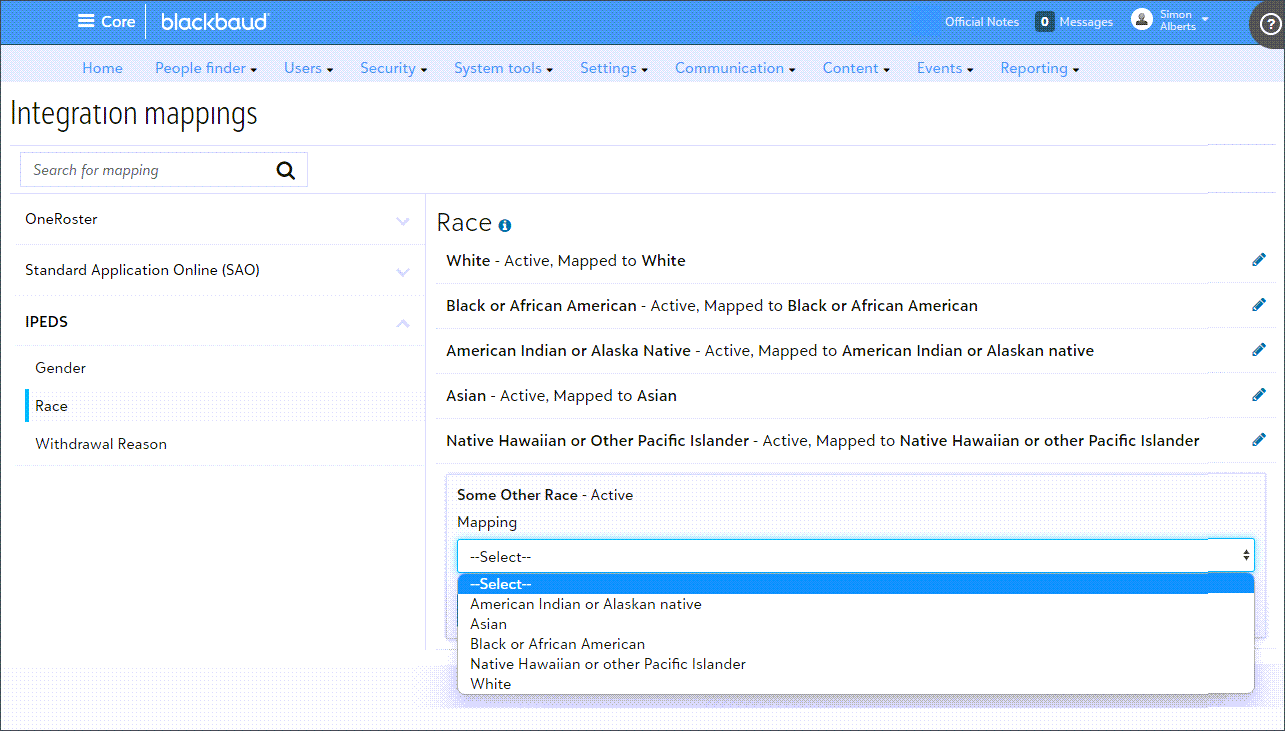
-
Select Save.
Note: After you configure Integration Mappings for IPEDS, wait until the following day to take further action. The mapped data (IPEDS gender, IPEDS race, and IPEDS withdrawal reason) is updated in the lists overnight.
The students' user profiles are the source of some IPEDS specific data fields for these lists. To update the data for a student in the list, go to their user profile in Core, select Contact card, and then select Edit under General information.
12 - Month enrollment
The 12-Month Enrollment (E12) form requires you to report unduplicated headcounts, instructional activity, and full-time equivalent enrollment for a 12-month period from July 1 through June 30. The report is broken down by undergraduate vs. graduate enrollment and by demographic categories.
For more information and step-by-step instructions on filling out the survey, see the IPEDS page on the National Center for Education Statistics website.
To report 12 - Month Enrollment for IPEDS, you'll need to use two list types:
-
Enrollments
-
Course enrollments
IPEDS Report: Part A - Unduplicated Report
You'll provide counts of degree, non-degree, full time, and part time students enrolled per year at your organization.
-
From the Education area, select Lists and then +List.
-
Select Enrollments and then OK.
-
Select Build a new list.
-
Select Columns. Search for and select these columns of data:
-
Contact card
-
First name
-
Last name
-
Preferred name
-
Cohort
-
Student ID
-
Date of birth
-
-
Federal reporting (IPEDS)
-
IPEDS gender
-
IPEDS race/ethniticy
-
IPEDS exclusion
-
-
Citizenship
-
U.S. Nonresident
-
Is Latino/Hispanic
-
-
Enrollment
-
School level (if your school has graduate and undergraduate levels)
-
-
-
Filter the list.
You should include current students, students who graduated, and students who left your school in the last year.
Apply the Enrollment filters for
-
Enrollment status - any of these values
-
School year - equal to
or Session start date and Session end date
-
-
Review the results in the filtered list. Depending how your school handles student records, the list might still include some alums who graduated or left the school prior to the relevant date range. If necessary, you can use other filters to remove false positives from the list.
-
With this filtered list, you are ready to fill in Part A - Unduplicated Count on the IPEDS 12-Month Enrollment report. You can either work with the list in your web browser or select Export to download it as a CSV spreadsheet file, which you can view and filter in a spreadsheet application (such as Microsoft Excel).
Note: There is no single filter setting that will create a perfectly curated list for your school. As an administrator, you will have to use your own knowledge of the student body to remove false positives and account for non-credit-seeking students (who are not counted in the IPEDS report).
-
Either in the browser or in your spreadsheet software, use additional filters to fill in each of the fields on the Unduplicated Count form. For example, to fill in the number of Black male students enrolled for undergraduate credit, you could set the IPEDS Gender filter to Male, set the IPEDS Race filter to Black or African American, and count the number of Undergraduate students in the resulting list.
Note: Refer to the IPEDS documentation for guidance on reconciling gender counts to overall student totals.
-
Consider saving the filtered lists that best meet your organization's needs for IPEDS reports. You can open the saved lists next year, edit them to use the new school year and dates, and save the changes.
Save with a new name if you want the results for historical purposes.
When you save a filtered list, any new data that meets the criteria of the existing filters will appear in the list the next time you view it.
You'll also determine who, if anyone, can view or manage the list in addition to you.
IPEDS Report: Part B - Instructional Activity
Next, you'll also report on instructional activity in terms of credits or clock hours.
Before you fill out data for Part B, you need to choose which Undergraduate Instructional Activity Type to report, as outlined on Page 2 of the IPEDS paperwork. Undergraduate instructional activity can be reported in units of clock hours or credit hours, while graduate-level instructional activity must be reported in credit hours.
The NCES gives the following explanation on the two activity types:
-
"Clock hours are a unit of measure that represent an hour of scheduled instruction given to students. "
-
"Credit hours are a unit of measure representing the equivalent of approximately one hour of instruction per week over the entire term. "
Select the method that best describes the units used to measure instructional activity at your institution.
Next, generate a list of Course enrollment data.
-
From the Education area, select Lists and then +List.
-
Select Course enrollments and then OK.
-
Select Build a new list.
-
Select Columns. Search for and select these columns of data:
-
Contact card
-
Cohort
-
Graduation year
-
Undergrad cohort
-
-
Course
-
Clock hours
-
Course code
-
Course credits
-
Course status
-
Course title
-
Drop date
-
School year
-
Student level
-
Term
-
Term begin date
-
Term end date
-
-
Enrollment
-
Entering enrollment status
-
Depart date
-
Enroll date
-
Withdrawal reason
-
-
Federal reporting (IPEDS)
-
IPEDS exclusion
-
-
-
Filter the list.
Include all terms that had instructional days within the reporting window for the IPEDS report (remember that the report covers July 1 - June 30).
If your school offers graduate or doctoral degrees, you may also need to filter based on undergrad cohort.
-
Review the results in the filtered list. If necessary, you can use other filters.
-
Consider saving the filtered lists that best meet your organization's needs for IPEDS reports. You can open the saved lists next year, edit them to use the new school year and dates, and save the changes.
Save with a new name if you want the results for historical purposes.
When you save a filtered list, any new data that meets the criteria of the existing filters will appear in the list the next time you view it.
You'll also determine who, if anyone, can view or manage the list in addition to you.
-
Select Export to download it as a CSV spreadsheet file, which you can view and filter in a spreadsheet application (such as Microsoft Excel).
-
Calculate instructional activity.
You are now ready to run calculations and fill in to "total activity" fields on IPEDS 12-Month Enrollment Part B - Instructional Activity. Use one of the following formulas to calculate Clock hour activity or Credit hour activity, depending on which reporting method your school has chosen.
Note: The following explanations are from the IPEDS documentation provided by the NCES. For more detailed definitions and examples, see the 12-Month Enrollment Full Instructions at the end of your paperwork from the IPEDS Survey Materials website. Also remember that for the purposes of the IPEDS report, you are required to only report on students who are enrolled for credit. Students who audit a course, for example, should be excluded from your totals.
|
Clock hour activity Clock Hour Activity of a Course = Course Clock Hour Value * Number of Students Enrolled for Credit Clock Hour Value of a Course: The clock hour value of a course is the number of hours per week that the course meets multiplied by the number of weeks the course is given. For example, a 3-week real estate licensure course that meets 15 hours per week has a value of 45 clock hours. Number of Students Enrolled for Credit: The number of students enrolled for credit at the close of the official add period for each program. If there is no official add period, report as of the 15th day of each regular program, and the 5th day of each short program. Example Calculation: Total clock hour activity for Institution ABC. Institution ABC offers 3 courses during the July 1, 2019 - June 30, 2020 reporting period:
Compute the clock hour activity for each course:
Compute the total clock hour activity for the institution by summing the clock hour activity for all courses offered for credit that are measured in terms of clock hours:
|
Credit hour activity Credit Hour Activity of a Course = Course Credit Hour Value * Number of Students Enrolled for Credit Number of Students Enrolled for Credit: The number of students enrolled for credit at the close of the official add period for each term. If there is no official add period, report as of the 15th day of each regular term and the 5th day of each summer or short term. Example Calculation: Total credit hour activity for Institution DEZ. Institution DEZ offers 3 courses during the July 1, 2019 - June 30, 2020 reporting period:
Compute the credit hour activity for each course:
Compute the total credit hour activity for the institution by summing the credit hour activity for all courses offered for credit and measured in credit hours:
|
Admissions
The IPEDS Admissions (ADM) survey component collects basic information about the undergraduate selection process for first-time, degree- or certificate-seeking students entering in the fall term. This survey component is collected from institutions that do not have an open admissions policy for all or most entering first-time students.
For more information and step-by-step instructions on filling out the survey, see the IPEDS page on the National Center for Education Statistics website.
To report Admissions for IPEDS you'll need two list types:
-
Admissions
-
Test scores
Step 1: Describe your admissions considerations
This step does not require any tools in Blackbaud Education Management. Select the option that best describes how your institution uses each admissions consideration (Secondary school GPA, Secondary school rank, etc.). Optionally, use the text box to provide additional context.
Step 2: Gather selection process data
Next, you will need to gather data on the numbers of applicants, admissions, and enrolled students, broken down by gender.
You'll report on admission considerations and the selection process (numbers).
-
From the Education area, select Lists and then +List.
-
Select Admissions and then OK.
-
Select Build a new list.
-
Select Columns. Search for and select these columns of data:
-
Applicant
-
Applicant decision
-
Applicant decision type
-
Applicant status
-
Decision
-
Decision type
-
Entering classification
-
Entering year
-
-
Contact card
-
First name
-
Last name
-
Preferred name
-
Cohort
-
Student ID
-
Date of birth
-
First-time student
-
Graduation year
-
Started in Fall term
-
Undergrad cohort
-
-
Federal reporting (IPEDS)
-
IPEDS gender
-
IPEDS race/ethniticy
-
IPEDS exclusion
-
-
Citizenship
-
U.S. Nonresident
-
Is Latino/Hispanic
-
-
Enrollment
-
Entering enrollment status
-
-
-
Filter the list.
-
Review the results in the filtered list. If necessary, based on how your school handles student records, you can use other filters to adjust the list.
-
With this filtered list, you are ready to fill in the Selection Process portion of the survey. You can either work with the list in your web browser or select Export to download it as a CSV spreadsheet file, which you can view and filter in a spreadsheet application (such as Microsoft Excel).
Note: There is no single filter setting that will create a perfectly curated list for your school. As an administrator, you will have to use your own knowledge of the student body to remove false positives and account for non-credit-seeking students (who are not counted in the IPEDS report).
-
Consider saving the filtered lists that best meet your organization's needs for IPEDS reports. You can open the saved lists next year, edit them to use the new school year and dates, and save the changes.
Save with a new name if you want the results for historical purposes.
When you save a filtered list, any new data that meets the criteria of the existing filters will appear in the list the next time you view it.
You'll also determine who, if anyone, can view or manage the list in addition to you.
Step 3: Gather test score data
Consult with your school's admissions office for data on the SAT and ACT scores of applicants. You'll report test schools to IPEDS.
-
From the Education area, select Lists and then +List.
-
Select Test scores and then OK.
-
Select Build a new list.
-
Select Columns. Search for and select these columns of data:
-
Test score
-
Overall score
-
Percentile
-
Score
-
Subtest
-
Test
-
Test date
-
-
Contact card
-
First name
-
Last name
-
Preferred name
-
Cohort
-
Student ID
-
Date of birth
-
First-time student
-
Graduation year
-
Started in Fall term
-
Undergrad cohort
-
-
Federal reporting (IPEDS)
-
IPEDS gender
-
IPEDS race/ethniticy
-
IPEDS exclusion
-
-
Enrollment
-
Enroll date
-
Entering enrollment status
-
FIPS code
-
FIPS code description
-
-
Citizenship
-
U.S. Nonresident
-
Is Latino/Hispanic
-
-
-
Filter the list.
-
Review the results in the filtered list. If necessary, based on how your school handles student records, you can use other filters to adjust the list.
-
With this filtered list, you are ready to fill in the Selection Process portion of the survey. You can either work with the list in your web browser or select Export to download it as a CSV spreadsheet file, which you can view and filter in a spreadsheet application (such as Microsoft Excel).
Note: There is no single filter setting that will create a perfectly curated list for your school. As an administrator, you will have to use your own knowledge of the student body to remove false positives and account for non-credit-seeking students (who are not counted in the IPEDS report).
-
Consider saving the filtered lists that best meet your organization's needs for IPEDS reports. You can open the saved lists next year, edit them to use the new school year and dates, and save the changes.
Save with a new name if you want the results for historical purposes.
When you save a filtered list, any new data that meets the criteria of the existing filters will appear in the list the next time you view it.
You'll also determine who, if anyone, can view or manage the list in addition to you.
Completions
Every fall, the IPEDS Completions survey collects the number of degrees and certificates awarded by field of study, award level, gender, age, and race/ethnicity.
The reporting period covers the 12 months beginning July 1 of the previous calendar year and ending June 30 of the current calendar year.
For more information and step-by-step instructions on filling out the survey, see the IPEDS page on the National Center for Education Statistics website.
To report Completions for IPEDS, you need a Student degrees list type.
-
From the Education area, select Lists and then +List.
-
Select Student degrees and then OK.
-
Select Build a new list.
-
Select Columns. Search for and select these columns of data:
-
Degrees/Certificates
-
Award level
-
CIP code(s)
-
Conferred on date
-
Degree
-
Degree concentrations
-
Degree type
-
Majors and concentrations
-
Minors
-
-
Contact card
-
First name
-
Last name
-
Preferred name
-
Cohort
-
Student ID
-
Date of birth
-
First-time student
-
Graduation year
-
Started in Fall term
-
Undergrad cohort
-
-
Federal reporting (IPEDS)
-
IPEDS gender
-
IPEDS race/ethniticy
-
IPEDS exclusion
-
-
Enrollment
-
Depart date
-
Enroll date
-
Entering enrollment status
-
FIPS code
-
FIPS code description
-
Withdrawal reason
-
-
Citizenship
-
U.S. Nonresident
-
Is Latino/Hispanic
-
-
-
Filter the list.
-
Review the results in the filtered list. If necessary, based on how your school handles student records, you can use other filters to adjust the list.
-
With this filtered list, you are ready to fill in the Completions portion of the survey. You can either work with the list in your web browser or select Export to download it as a CSV spreadsheet file, which you can view and filter in a spreadsheet application (such as Microsoft Excel).
Note: There is no single filter setting that will create a perfectly curated list for your school. As an administrator, you will have to use your own knowledge of the student body to remove false positives and account for non-credit-seeking students (who are not counted in the IPEDS report).
-
Consider saving the filtered lists that best meet your organization's needs for IPEDS reports. You can open the saved lists next year, edit them to use the new school year and dates, and save the changes.
Save with a new name if you want the results for historical purposes.
When you save a filtered list, any new data that meets the criteria of the existing filters will appear in the list the next time you view it.
You'll also determine who, if anyone, can view or manage the list in addition to you.
Small schools - Filter the list
Smaller schools, generally with enrollments of 100 or fewer, may want to fill out the IPEDS Completions report by applying Filters and then selecting column header to sort the data.
For example, to calculate the number of female students who earned an Associate’s Degree in CIP Code 3.4321, you would set the Gender filter to Female, set Degrees to Associate of Arts, and set Graduation year to the relevant graduation years.
Then, simply count the rows in the list results.
Large schools - Export the list
Schools with a large number of students, may want to Export your list results to a CSV file and open it in a spreadsheet application (such as Microsoft Excel).
When you use a spreadsheet application as you fill out the IPEDS Completions report, consider these tips and best practices.
The examples below are based on Microsoft Excel. However, other applications (including Google Sheets) have similar capabilities.
-
Create a Pivot Table from your data to quickly calculate student counts.
For example, to find the Ethnicity counts for each combination of CIP Code and Degree, you would click and drag Student Summary to the Values box, then add CIP Code, Degrees, Area of studies, and Ethnicity to the Rows box.
-
You are required to report the number of students completing each award level “By Age” for IPEDS.
To find the ages of your students on their award dates, create a new column and label it Age at Degree. Then use a formula to calculate the student’s age based on the existing columns Date of Birth and Conferred on dates.
For example, if Birthdate is in Column J and Conferred on Dates is in Column K, the formula might look like:
=(K2-J2)/365.25. (The additional .25 in the denominator is to account for leap years.)Select and drag the corner of this cell to apply it to all of the rows beneath it. Then sort the Age at Degree column data into the age ranges requested for IPEDS (Under 18, 18-24, 25-39, 40 and Above, and Age Unknown).
Fall Enrollment
The Fall Enrollment component of the IPEDS survey collects student enrollment data including level of student, enrollment status, gender, and race/ethnicity.
Your schools may be required to submit different data depending on whether your school is 2-year or 4-year, whether it grants degrees, and whether the current year is odd-numbered or even-numbered.
For more information and step-by-step instructions on filling out the survey, see the IPEDS page on the National Center for Education Statistics website.
To report Fall enrollment for IPEDS , you'll need two list types:
-
Enrollments
-
Student degrees
For this report, you'll provide an duplicated enrollment count, as well as information about distance education, age breakdown, first-time students by FIPS code, size of entering class, cohort retention, and student-to-faculty ratio.
Step 1: Collect fall enrollment data; generate gender and age data, generate state residency data
Follow the instructions under Part A of the Fall Enrollment survey to determine whether to report enrollment as of your institution's official fall reporting date, as of October 15, or for any students enrolled between August 1 and October 31.
You'll use an Enrollments list to complete Part A:
-
From the Education area, select Lists and then +List.
-
Select Enrollments and then OK.
-
Select Build a new list.
-
Select Columns. Search for and select these columns of data:
-
Contact card
-
First name
-
Last name
-
Preferred name
-
Cohort
-
Student ID
-
Date of birth
-
First time student
-
Student status
-
Undergrad cohort
-
Started in Fall term
-
Gender
Note: Use this to collect information about students for whom gender does not fit the binary gender (Men/Women) categories provided. At this time, you'll still use the IPEDS gender field to map values for those students to the Men/Women categories in other screens of the survey component.
-
-
Federal reporting (IPEDS)
-
IPEDS gender
-
IPEDS race/ethniticy
-
IPEDS exclusion
-
-
Citizenship
-
U.S. Nonresident
-
Is Latino/Hispanic
-
-
Enrollment
-
School level (if your school has graduate and undergraduate levels)
-
Enroll date
-
Credits attempted
-
Classification
-
Enrolled for credit
-
Entering enrollment status
-
FIPS code
-
FIPS code description
-
School level
-
School year
-
Session
-
Session begin date
-
Session end date
-
-
Addresses
-
Primary address
-
-
-
Filter the list.
Apply the Enrollment filters for
-
Enroll date - You can also select the column header to sort the list chronologically.
-
Enrollment status - any of these values
-
School year - equal to
or Session start date and Session end date
For Part B, you'll also Apply the Contact card filters or sort columns by Gender and Date of Birth.
-
-
For Part C, you need to sort columns by FIPS code, Primary address, or U.S. Nonresident.
Note: This section of the survey is only mandatory during even-numbered years.
-
Review the results in the filtered list. If necessary, based on how your school handles student records, you can use other filters to adjust the list.
-
With this filtered list, you are ready to fill in Part A , Part B, and Part C on the IPEDS Fall Enrollment report. You can either work with the list in your web browser or select Export to download it as a CSV spreadsheet file, which you can view and filter in a spreadsheet application (such as Microsoft Excel).
Note: There is no single filter setting that will create a perfectly curated list for your school. As an administrator, you will have to use your own knowledge of the student body to remove false positives and account for non-credit-seeking students (who are not counted in the IPEDS report).
-
Either in the browser or in your spreadsheet software, use additional filters to fill in each of the fields on the IPEDS Fall Enrollment report.
Note: Refer to the IPEDS documentation for guidance on reconciling gender counts to overall student totals. Use the Date of Birth to calculate student ages as of August 1. This section of the survey is only mandatory during odd-numbered years.
-
Consider saving the filtered lists that best meet your organization's needs for IPEDS reports. You can open the saved lists next year, edit them to use the new school year and dates, and save the changes.
Save with a new name if you want the results for historical purposes.
When you save a filtered list, any new data that meets the criteria of the existing filters will appear in the list the next time you view it.
You'll also determine who, if anyone, can view or manage the list in addition to you.
Step 2: Calculations
For Parts D through F, you will make calculations based on data you already entered in this year's IPEDS survey, data you entered in last year's survey, and faculty information provided by your institution's human resources department.
You'll enter information about the
-
total undergraduate entering class,
-
retention rates for the first-time bacholor's degree seeking student cohort
-
and student to faculty ratio
In addition to the Enrollments list from the previous step, you'll also use data from a Student Degrees list.
-
From the Education area, select Lists and then +List.
-
Select Student degrees and then OK.
-
Select Build a new list.
-
Select Columns. Search for and select these columns of data:
-
Degrees/Certificates
-
Award level
-
CIP code(s)
-
Conferred on date
-
Degree
-
Degree concentrations
-
Degree type
-
Majors and concentrations
-
Minors
-
-
Contact card
-
First name
-
Last name
-
Preferred name
-
Cohort
-
Student ID
-
Date of birth
-
First-time student
-
Graduation year
-
Started in Fall term
-
Undergrad cohort
-
-
Federal reporting (IPEDS)
-
IPEDS gender
-
IPEDS race/ethniticy
-
IPEDS exclusion
-
-
Enrollment
-
Depart date
-
Enroll date
-
Entering enrollment status
-
FIPS code
-
FIPS code description
-
Withdrawal reason
-
-
Citizenship
-
U.S. Nonresident
-
Is Latino/Hispanic
-
-
-
Filter the list.
-
Review the results in the filtered list. If necessary, based on how your school handles student records, you can use other filters to adjust the list.
-
With this filtered list and the previous Enrollments list, you are ready to fill in Part D through Part F of the Fall enrollments portion of the survey. You can either work with the list in your web browser or select Export to download it as a CSV spreadsheet file, which you can view and filter in a spreadsheet application (such as Microsoft Excel).
Note: There is no single filter setting that will create a perfectly curated list for your school. As an administrator, you will have to use your own knowledge of the student body to remove false positives and account for non-credit-seeking students (who are not counted in the IPEDS report).
-
Consider saving the filtered lists that best meet your organization's needs for IPEDS reports. You can open the saved lists next year, edit them to use the new school year and dates, and save the changes.
Save with a new name if you want the results for historical purposes.
When you save a filtered list, any new data that meets the criteria of the existing filters will appear in the list the next time you view it.
You'll also determine who, if anyone, can view or manage the list in addition to you.
Graduation Rates
The Graduation Rates component of the IPEDS survey collects data on a cohort of full-time, first-time undergraduate students. The main question it seeks to answer is: How many students in a cohort complete the program within 150 percent of the normal completion time? For example, in a cohort of students seeking a 4-year bachelor's degree, you will report how many of those students completed the degree within 6 years.
Note: Reporting requirements vary based on whether your school offers a 4-year, 2-year, or less-than-2-year program, and on whether you are an academic reporter or a program reporter. For more information and step-by-step instructions on filling out the survey, see the IPEDS page on the National Center for Education Statistics website.
Tip: If your school needs sub-cohorts, such as "Bachelor's seeking students" and "Other (Associate's degree, etc.)" , then an administrator can create them. In Core, go to Settings, General settings, and then Custom fields. See the help topic Custom User Fields for details. Then use a Student list from Academics to view the data from the custom user field.
To report Graduation rates for IPEDS, you'll use a Student degrees list type.
-
From the Education area, select Lists and then +List.
-
Select Student degrees and then OK.
-
Select Build a new list.
-
Select Columns. Search for and select these columns of data:
-
Degrees/Certificates
-
Award level
-
CIP code(s)
-
Conferred on date
-
Degree
-
Degree concentrations
-
Degree type
-
Majors and concentrations
-
Minors
-
-
Contact card
-
First name
-
Last name
-
Preferred name
-
Cohort
-
Student ID
-
Date of birth
-
First-time student
-
Graduation year
-
Started in Fall term
-
Undergrad cohort
-
-
Federal reporting (IPEDS)
-
IPEDS gender
-
IPEDS race/ethniticy
-
IPEDS exclusion
-
-
Enrollment
-
Depart date
-
Enroll date
-
Entering enrollment status
-
FIPS code
-
FIPS code description
-
Withdrawal reason
-
-
Citizenship
-
U.S. Nonresident
-
Is Latino/Hispanic
-
-
-
Filter the list for each relevant cohort.
For example, to report graduation rates for a 4-year bachelor's degree, select the cohort from 6 years ago. To report graduation rates for a 2-year associate's degree, select the cohort from 3 years ago, and so on.
-
Review the results in the filtered list. If necessary, based on how your school handles student records, you can use other filters to adjust the list.
-
With this filtered list, you are ready to fill in the Graduation rates portion of the survey. You can either work with the list in your web browser or select Export to download it as a CSV spreadsheet file, which you can view and filter in a spreadsheet application (such as Microsoft Excel).
Use care while following the instructions on the IPEDS form. For example, if the form tells you to exclude part-time students from a cohort, you can filter the list by the Entering enrollment status column to only display full-time students.
Note: There is no single filter setting that will create a perfectly curated list for your school. As an administrator, you will have to use your own knowledge of the student body to remove false positives and account for non-credit-seeking students (who are not counted in the IPEDS report).
-
Consider saving the filtered lists that best meet your organization's needs for IPEDS reports. You can open the saved lists next year, edit them to use the new school year and dates, and save the changes.
Save with a new name if you want the results for historical purposes.
When you save a filtered list, any new data that meets the criteria of the existing filters will appear in the list the next time you view it.
You'll also determine who, if anyone, can view or manage the list in addition to you.
Graduation rates 200%
The Graduation Rates 200% component of the IPEDS survey is similar tot he Graduation Rates component. It collects data on a cohort of full-time, first-time undergraduate students. The main question it seeks to answer is: How many students in a cohort complete the program within 200 percent of the normal completion time?
For example, in a cohort of students seeking a 4-year bachelor's degree, you will report how many of those students completed the degree within 8 years.
To complete the Graduation Rates 200% component, follow the steps listed above for Graduation Rates, but use a 200% cutoff instead of a 150% cutoff.
Note: Reporting requirements vary depending on whether a school offers a 4-year, 2-year, or less-than-2-year program, and on whether you are an academic reporter or a program reporter. For more information and step-by-step instructions on filling out the survey, see the IPEDS page on the National Center for Education Statistics website.
To report Graduation rates 200% for IPEDS, you'll need a Student degrees list type.
Outcome measures
The Outcome Measures (OM) component of IPEDS collects award and enrollment data from degree-granting institutions regarding 4 undergraduate cohorts and 8 undergraduate sub-cohorts. You need to collect data at 3 status points: 4 years, 6 years, and 8 years after entry.
Note: For more information and step-by-step instructions on filling out the survey, see the IPEDS page on the National Center for Education Statistics website.
To start, you need to identify the entering degree- or certificate-seeking undergraduate students for the full year listed on the Outcome Measures survey. This is a group of students who entered 8 years ago.
You'll then break this group of undergraduates down into 4 cohorts based on their status when they enrolled:
-
First-time, full-time entering (FTFT)
-
First-time, part-time entering (FTPT)
-
Non-first-time, full-time entering (NFTFT)
-
Non-first-time, part-time entering (NFTPT)
You'll then break down each cohort into two groups:
-
Pell Grant recipients
-
and Non-Pell Grant recipients.
Ultimately, each student is sorted into one of 8 sub-cohorts.

You'll also count the number of IPEDS exclusions.
Tip: If your school has configured custom fields, which appear on student profiles, such as sub-cohort identities, you can use a Student list from Academics to view the data from the custom user field. You can also identify student who have been marked Is deceased as columns in the list. Alternatively, use the People list from the Education area and Analysis to view the Deceased and Deceased date and columns.
To report Outcome measures for IPEDS, you'll need a Student degrees list type.
-
From the Education area, select Lists and then +List.
-
Select Student degrees and then OK.
-
Select Build a new list.
-
Select Columns. Search for and select these columns of data:
-
Degrees/Certificates
-
Award level
-
CIP code(s)
-
Conferred on date
-
Degree
-
Degree concentrations
-
Degree type
-
Majors and concentrations
-
Minors
-
-
Contact card
-
First name
-
Last name
-
Preferred name
-
Cohort
-
Student ID
-
Date of birth
-
First-time student
-
Graduation year
-
Started in Fall term
-
Undergrad cohort
-
-
Federal reporting (IPEDS)
-
IPEDS gender
-
IPEDS race/ethniticy
-
IPEDS exclusion
-
-
Enrollment
-
Depart date
-
Enroll date
-
Entering enrollment status
-
FIPS code
-
FIPS code description
-
Withdrawal reason
-
-
Citizenship
-
U.S. Nonresident
-
Is Latino/Hispanic
-
-
-
Filter the list for each relevant cohort.
You should include current students, students who graduated, and students who left your school in the last year.
Tip: To identify students who passed away, use the People list and include the Deceased and Deceased date and columns.
As you fill out the Outcome Measures report, filter the list as needed using the Entering enrollment status and First-time student columns. For example, you'll uses these filters to generate a list of first-time full-time (FTFT) students, ie. students who are both Full time (for Entering enrollment status) and First-time student
Consult with your school's financial aid department to determine which students are Pell Grant recipients and which students are not.
Tip: Consider entering Pell grant status as an admin-only field on each student's user profile. Then use a Student list from Academics to view the data from the custom user field. For more information on creating admin-only fields, see the help topic Custom user fields .
-
Review the results in the filtered list. If necessary, based on how your school handles student records, you can use other filters to adjust the list.
-
With this filtered list, you are ready to fill in the Outcome measures portion of the survey. You can either work with the list in your web browser or select Export to download it as a CSV spreadsheet file, which you can view and filter in a spreadsheet application (such as Microsoft Excel).
Note: There is no single filter setting that will create a perfectly curated list for your school. As an administrator, you will have to use your own knowledge of the student body to remove false positives and account for non-credit-seeking students (who are not counted in the IPEDS report).
-
Consider saving the filtered lists that best meet your organization's needs for IPEDS reports. You can open the saved lists next year, edit them to use the new school year and dates, and save the changes.
Save with a new name if you want the results for historical purposes.
When you save a filtered list, any new data that meets the criteria of the existing filters will appear in the list the next time you view it.
You'll also determine who, if anyone, can view or manage the list in addition to you.
